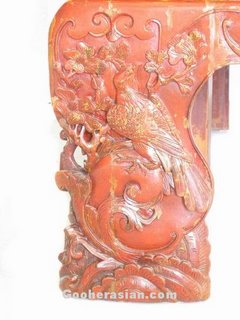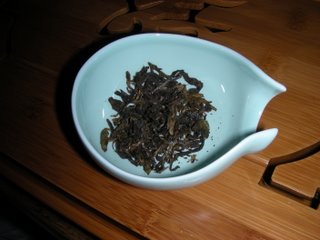My pu-erh orders are here!!! I came home around mid-nite last night from the long Thanksgiving weekend, found 2 large packages from China in the mail box. My heart started pounding as soon as I smell the faint pu-erh aroma leaked through the card board boxes. 72 cakes all together! Imagine my excitement! Yay!!!

2006 Hai Lang Hao Lao Ban Zhang raw pu-erh cake
Dry leaves: This cake looks very attractive, a lot of young silver hairy leaves, both on top and bottom of the cake. A sign of quality leaves. Fresh tobacco mixed with floral or spring forest aroma. Something I notice is the hole in the bottom is not centered nor smooth as it came out of a mold. I am baffled by this irregularity.

2.5 g, gaiwan, hot boiling water, no pre-wash
1st brew: 10s, golden yellow, fresh tobacco aroma with a hint of sweetness, crisp clean and fresh mouth, sign of typical young pu, the smoky sweet taste gives an aged feel, however a 2006 young pu should be too fresh to have such flavor, unless it's harvested early 2006 and stored with high humidity. I found my other 2006 wild pu starting to give out aging flavor about 1 month ago, provided that I stored it in its own wrapping with a lot of ocean humidity since June.
2nd brew: 10s, deep golden yellow, less aroma, sweeter, more intense taste, still some tobacco, after taste is intense
3rd brew: 10s, similar to 2nd
4th brew: 15s, less sweet, tobacco flavor still remains
5th, 6th and on: 20s, 30s, 45s, lighter color, still tobacco, but pleasant, hint of sweetness, after taste is long lasting
Open leaves: Large leaves, young and tender, reddish brown - a sign of fermentation. I wonder if it's over fermented, therefore gives out more tobacco flavor then it should be. By the size of the leave, it seems like authentic Yunnan large leave wild varietal. I have questions in my mind about this cake. Maybe it will take some time to discover its true flavor with another brewing method.
It's still giving out flavor at 10th brew, long lasting. I am not impressed yet at this first tasting. For $37 a cake plus shipping, I am not sure about the flavor at this point. Leaves looking this good with a flavor not measuring up to the PQR (price quality ratio), I hope I can find out more in future tastings.
This tea is highly caffeinated, I can feel the effect after more than an hour. After not drinking caffeinated tea for 5 days, I wonder if my body has lowered its tolerance for caffeine?!
Seller's remark:
This is one of few teas that I (as an experienced drinker of raw/Sheng Pu) actually experience a sort of drunken or heightened state when I drink.
HA! Now I know why!




















